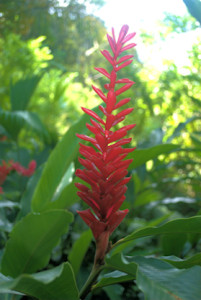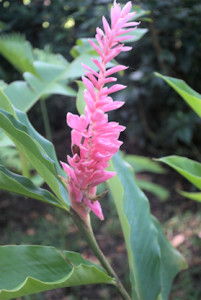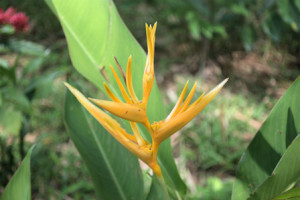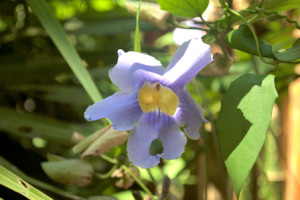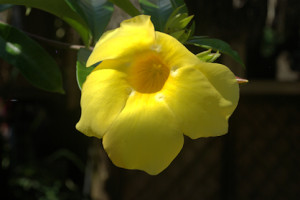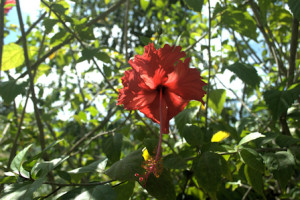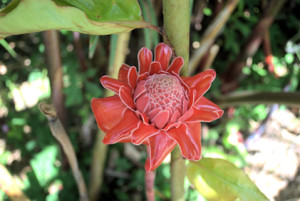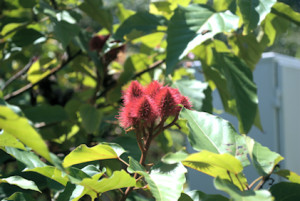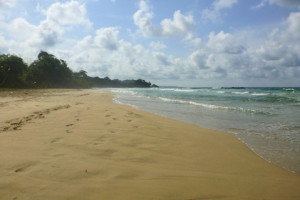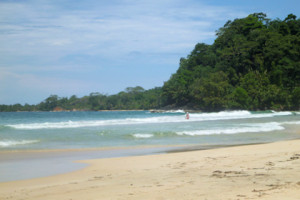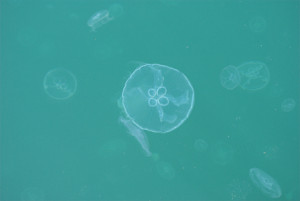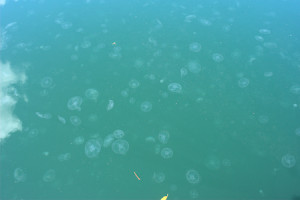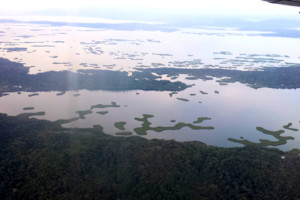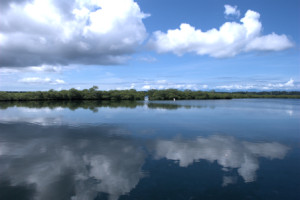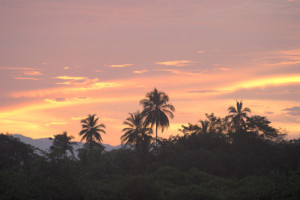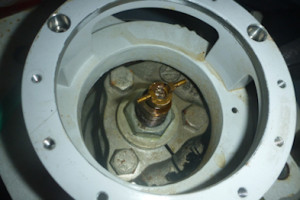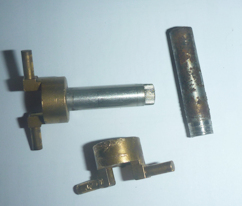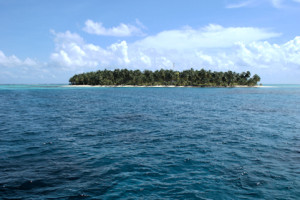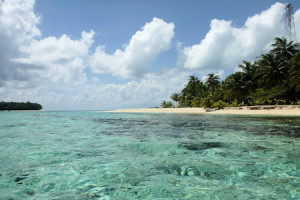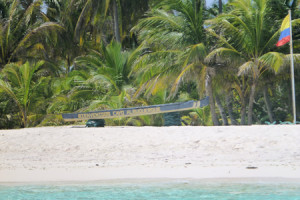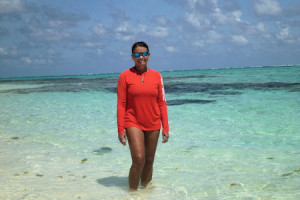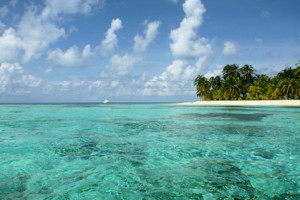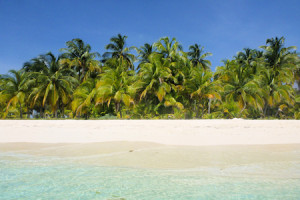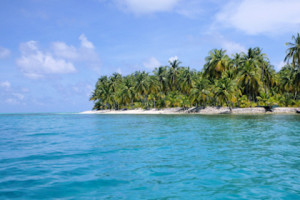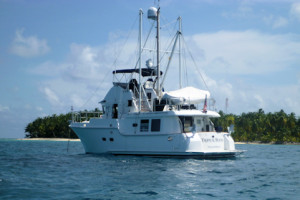September 2nd – 3rd, 2014: Shelter Bay Marina – Bocas del Toro (Red Frog Marina)
Free from Shelter Bay at last, we decided to skip the intermediate stops and cruise straight to Red Frog, an overnight passage. The weather forecast was good, but after sunset, we started to get some squalls and a lot of lightning. The seas picked up and were on our beam. We have hydraulic stabilizers, but the starboard fin had been very noisy, getting worse as our voyage progressed. It had been knocking on occasion when the fin would pass through its center point. But on this passage, it was knocking every time, and you could feel it through the hull. It was so bad, we decided to turn off the stabilizers, since we didn’t know if they could be damaged by the knocking. This caused us to start rolling, and poor Susie (without sea legs) got sick. It was a tough night, what with dodging squalls and lightning, with intermittent rain forcing to close up an already hot boat. I don’t think this was a very good introduction to cruising for Susie.
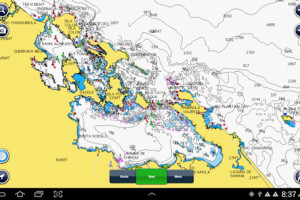 Red Frog Marina is a relatively new marina located on the south side of Isla Bastimentos. We picked this marina because it was close to a beach and it had great reviews. It’s quite a ways to get there once inside the bay, about five nautical miles. It’s very well protected, with no surge. Even during this low season, it was almost full. The marina manager and staff are very helpful, and we tied up without incident.
Red Frog Marina is a relatively new marina located on the south side of Isla Bastimentos. We picked this marina because it was close to a beach and it had great reviews. It’s quite a ways to get there once inside the bay, about five nautical miles. It’s very well protected, with no surge. Even during this low season, it was almost full. The marina manager and staff are very helpful, and we tied up without incident.
Position at destination: 9°20’ N, 82°10.7’ W
Air temp: 89 Humidity: 70% Water temp: 87
Nautical miles for this leg: 146.6 Total: 4859
Departed at 12:10pm, arrived at 3:00pm
September – October 2014: Red Frog Marina, Bocas del Toro
Bocas del Toro is an archipelago with countless mangrove islands and many coral reefs. It has a large expat community – many Americans have relocated here either for retirement, or to run small businesses. It’s laid-back like the rest of Panama, with the main settlement of Bocas Town in Isla Colon, about four miles by boat from Red Frog. The marina provides a free shuttle in the morning to Bocas Town, allowing enough time for provisioning and lunch. There are a number of small groceries in town, including The Gourmet Store, where we found some items we hadn’t seen since leaving the USA. There is also Tutty ‘n Fish, which offers frozen fish, beef, poultry, and pork products – very good quality at decent prices. We mainly relaxed and enjoyed the beach and rainforest while we were at Red Frog. We had a rough plan to leave around the end of October, when the risk of late-season hurricanes in the Western Caribbean is minimal.
The Marina
The marina is very modern, with floating docks made with artificial wood, making for a smooth, splinter-free surface. It was a long walk to the bathrooms. While not air-conditioned, the bathrooms had rotating fans inside, which made all the difference. They were like en-suite bathrooms, each with toilet, sink, and shower. The marina office is located in the rainforest. Once morning returning from the bathroom, I saw a baby sloth making its way (with difficulty) across the walkway. Of course, I had no camera with me. I hurried back for a camera, but by that time it was well up in the trees with its mother.
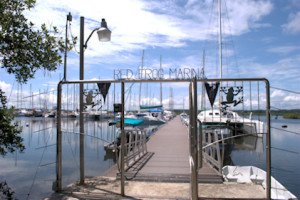
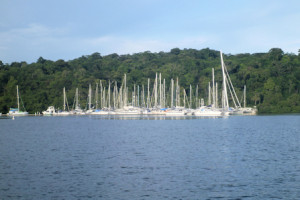 Marina entrance gate Very full Red Frog Marina
Marina entrance gate Very full Red Frog Marina
The Rainforest
The forest on Isla Bastimentos is the home of the red frogs that the marina is named after. They are poisonous, as advertised by their red skin. You can hear them at night, but we had a hard time finding them, as they are about the size of a thumbnail. With great patience, Rosé managed to find one. The forest was rich in color and diversity. Considering that on average, we received a half an inch of rain per day, it wasn’t surprising.
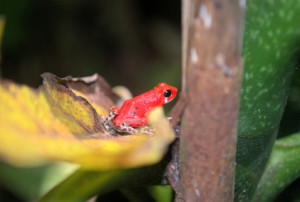
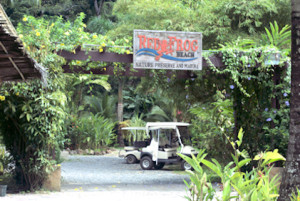
We finally saw a Red Frog! Office area with path to the beach

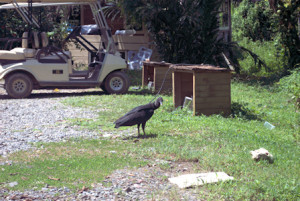 With beauty sometimes comes ugliness
With beauty sometimes comes ugliness
The Beach
The beach on the north side of Bastimentos was about a ten-minute walk through the forest. Most days, there was a mild surf, but on occasion, it was up enough for surfing. I enjoyed a number of days on the boogie board. In the afternoons, there were some Kuna children on the beach selling coconut oil and other items. We had bought a couple of large bags of hard candy when we were in Colon, so we took some over to give to the kids. This made us their friends, and they would hang out for a while under our beach umbrella. A couple of girls told Rose that they were learning English, and recited their knowledge of colors – very cute. There were a few restaurants at the beach, and most of the people were staying in the villas. On weekends, a lot of local people came over from Isla Colon. The water temperature was in the high 80’s, and we thoroughly enjoyed the beach.
One of the few issues we had with Red Frog was the incredible amount of moon jellyfish in the water. When we first arrived, the marina manager told us that it was their mating season, and that they would soon be gone. That never happened – they were always present. We guessed that there were at least two or three in each square foot of water. But the views on the calm water, and the sunsets, were really spectacular.
The Marina Community
There were a lot of live-aboards in the marina, at least for the duration of hurricane season. Docked next to us was Albatross, a Nordhavn 40 owned by a delightful Dutch couple, Rita and Anton. Albatross was hull number 2 of the N40 series. They had come down from Florida following the same route that we would be taking up to Florida, and Anton shared his waypoints and gave us their cruising guide to Belize and the Caribbean coast of Mexico. Anton was very partial to German food, and he told us about a great restaurant in Guanaja, off the coast of Honduras. Their boat did not have hydraulic stabilizers, and he gave me a very simplified procedure for deploying and retrieving the paravanes. These are passive fins deployed from poles that extend from the boat, like you would see on a fishing trawler. Some sailors refer to the fins as birds. We had only deployed them once very briefly, when we moved Tropical Blend from southern to northern California. The captain that came with us guided us through the procedure, but neither one of us remembered it. The boat manual had a very complicated procedure, as did a guide from Nordhavn owner Milt Baker. But Anton’s guide was very easy to follow.
We made a number of friends at the marina, as we met many of the same people of the runs into Bocas Town. In October, a produce boat started coming to Red Frog on Saturday mornings, and we would all turn out to buy fresh from the farm, inexpensive produce. The marina atmosphere was very social. One Saturday, a new restaurant opened in the forest near the beach, and all the marina tenants were invited for free drinks and appetizers. It was a beautiful place, fitting naturally into the forest, and operating in a very green manner. There were always a few megayachts docked in the marina, including our old friend White Shark from Shelter Bay. We found out the story of the White Shark’s exodus from Shelter Bay. They were planning to go to the big marina on the Pacific side of the canal, Flamenco Marina. That marina is VERY expensive, and you can almost never get into it – most of the boats there are year-around sportfishers. When we called them for reservations back in May, they told us they were planning to open new docks in June, which moved to July, and finally August. White Shark had a plan to move to the new docks, but before they were completed, a large swell event on the Pacific side damaged the new docks considerably. So instead, White Shark relocated to Red Frog, and they left late in September for parts unknown.
The community was active and friendly, and you would always see someone from the marina at the beach bar. Help for boating issues was readily available, and cruising information was easy to come by. There was a large contingent of Dutch people at the marina for some reason, but they were very friendly. We’d certainly recommend staying at this marina for hurricane season.
Repairing the stabilizer
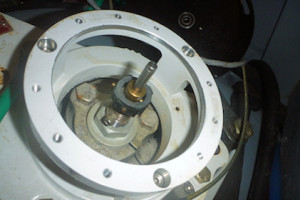 I sent an e-mail to NAIAD, the manufacturer of our hydraulic stabilizer, describing the symptoms. They responded back that it was probably the potentiometer (fin position sensor). They had me test the sensor my loosening the bolts on it while it was on in the dock. As soon as I did that, it violently chattered. The conclusion from NAIAD was a faulty potentiometer, and a replacement cost $450 – ouch! I ordered the new part to be sent direct to the marina. After it arrived, I set about removing the old one. I quickly discovered that NAIAD didn’t design this part for easy removal. You have to take out some set screws, and one of them is virtually impossible to reach, being blocked by a standoff. I didn’t seem to have the right hex key wrench, so I borrowed a set from our neighbor, but that didn’t help. I finally found a mechanic on our dock who could help me. By hook and by crook, and using vise grips, we were finally able to remove the old potentiometer.
I sent an e-mail to NAIAD, the manufacturer of our hydraulic stabilizer, describing the symptoms. They responded back that it was probably the potentiometer (fin position sensor). They had me test the sensor my loosening the bolts on it while it was on in the dock. As soon as I did that, it violently chattered. The conclusion from NAIAD was a faulty potentiometer, and a replacement cost $450 – ouch! I ordered the new part to be sent direct to the marina. After it arrived, I set about removing the old one. I quickly discovered that NAIAD didn’t design this part for easy removal. You have to take out some set screws, and one of them is virtually impossible to reach, being blocked by a standoff. I didn’t seem to have the right hex key wrench, so I borrowed a set from our neighbor, but that didn’t help. I finally found a mechanic on our dock who could help me. By hook and by crook, and using vise grips, we were finally able to remove the old potentiometer.
The top picture shows one of the set screws holding the shaft on place. Clean access to the second one was impeded by the standoff as earlier stated. The second shot shows the removal in progress, which required some serious wrenching using a vise grip. The final picture shows the three pieces that were so tough to remove. You can see the scoring on the shaft that was probably causing the chattering. Thanks to some mix-ups, NAIAD actually sent and billed me for two of the sensors. I was initially going to return one, but I figured that of the starboard unit failed, the port one wouldn’t be far behind. Access to the starboard fin control was easy, through a lifted hatch in the master head shower. Access to the port side would be much worse, as it was under a drawer, and even more difficult to access. Anyway, installing the new sensor was much easier than removing the old one, and I calibrated it into position. All that was left was a sea trial.
For the sea trial, I invited Rita and Anton, so I could also practice deploying the paravanes. Unfortunately, the day we went out was very calm, but I could tell that the fin was operating in a normal, quiet fashion. Deploying the paravanes wasn’t too difficult, but retrieving them was a whole other matter. The fins weigh around forty pounds each. When deployed, they hang from the end of the poles at a depth of fifteen or so feet below sea level. There is a retrieval line attached to the fin and tied off at the stern. To retrieve the fins, Anton told me to first raise the poles to at least a 45° position, which was really difficult. He suggested that I leap up while holding the pole lifting line, allowing my body weight to pull the poles up with gravity. Once this was done, we went to the stern and retrieved the fin as far as we could using the retrieval line. Then we attached the chain holding the fins to the winch, and brought them to the surface, where we could just grab them. The final step was to lift the fin out of the water and place it into the holder on the stern – not easy! I can’t imagine doing this on rough seas. You have to stop all forward motion of the boat. I really saw this as a three-person job: two to retrieve the fins, and one to keep the bow into the waves as much as possible. I hope that we never have to use them in a passage.
October 29th – 30th: Bocas del Toro to Cayo Albuquerque, Columbia
The Boat Document snafu
We originally planned to leave for Cayo Albuquerque and Providencia on Saturday, October 25th. We arranged for the Port Captain to come to Tropical Blend on Friday for check-out procedures. We also expected immigration and customs at that time. The Port Captain was an hour late, not surprising in Panama, but he only brought one other officer with him, who turned out to be his assistant. As soon as we handed over our boat document, he pointed out that it had expired on August 31st – d’oh! Our mail forwarder in Florida (SBI) acts as our agent for the Coast Guard document, which has to be renewed annually. They had previously renewed the document on Blender Boy, placing a scanned copy in our folder and eventually forwarding the original. I couldn’t remember seeing the Tropical Blend document in our folder or in our mail, and I did a frantic search of both computers and the SBI files – nada.
Despite this, the Port Captain was willing to give us the exit Zarpe. We asked him what would happen when we arrived in Columbian territory – he thought that they would check us in with the Zarpe, but would probably not issue an exit Zarpe until we had a current boat document. Given that Providencia is really remote, and we weren’t sure if we could find Internet and/or phone service, we decided that we had to renew it while we were in Bocas. The Port Captain gave us a Zarpe good for one week (normally, it is good for 48 hours). He took our cruising permit, and told us that if we could not get the document within a week, we could come to his office to pick up our cruising permit, and that the Zarpe would have to be processed later, for another fee. The extra week cost us an extra one hundred dollars, which we suspect went into his pocket.
After he left, I called SBI, and they searched our mail records in vain. I also checked the USCG site, to find that our expiration date was now “*”, which I took to be expired. I pieced together what happened: I never gave the change of address to the USCG, as it never occurred to me. We were still getting some mail forwarded from our old address, but apparently not this very important document. I called the USCG to see how quickly we could get this done. They told me that I would have to pay $84 for reinstatement and another $4 to get a certified copy faxed. I asked about priority handling – they told me to attach a request for that, per the instructions on the site. It would normally be two or three days, but no guarantees. I quickly downloaded the form from their site and submitted the reinstatement application, explaining how it had lapsed, and requesting priority handling. Amazingly, the express service doesn’t cost extra, but there are no guarantees that they will grant it. I explained that we were stuck in Panama, trying to leave before the northers of autumn and winter started. After that, there was nothing to do but wait. We spent a lazy weekend, finishing up cleaning and organizing the boat.
On Monday morning we went to Bocas for a last provisioning run. I called the USCG while we were having breakfast and found out that the priority handling request had been approved. Again, they would not say when it would be finished, but that it could be very quick. We picked up a few more provisions, including a machete, which would double as a coconut basher and a pirate basher. That night, I checked email, and voila – we had the document! Of course, as a certified copy, it didn’t say “certified copy” on it anywhere – just a repeating watermark of “VOID” all over it. Being concerned how a foreign port might view this, I called the USCG the next morning and asked about it, but they said this is the way the certified copies are issued. I did have their cover letter, so we could only hope for the best. I went to let Dan, the marina manager, know that we would be leaving, and he told me that we should have zero problems with the “VOID” certified copy.

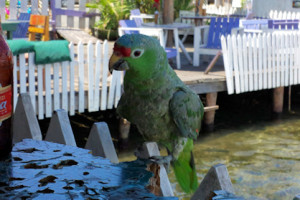
This little fella often joined us for drinks at a waterfront bar
We went to town on the 9:45 shuttle and proceeded to the Port Captain’s office. Inside, we saw his assistant, whom we had assumed previously was the immigration officer. He told us to go to immigration, which was the two-story white building just past the town plaza. On the way, we stopped at a store for a drink, and noticed there was no power. There was actually no power in the town. We were envisioning that the immigration office would not be able to process us due to the lack of power, but onward we trudged, sweating all the way. We went upstairs in the building, which was being renovated. There was an extremely loud and smelly portable generator just outside the immigration office – which was closed, by the way. We hoped that the officer was on a short break, and we decided to go to the German bakery for some bread, and then to the bank. We didn’t know if the ATM would be working or not due to the power outage, but it was. Maybe it has a backup power supply. We returned to the second floor immigration office and the very obnoxious generator to find the office still closed. There was a mobile number listed on it, so we walked down to the plaza to call.
The call was answered by a lady that spoke English well, and she told me she would be back in a couple of minutes. She actually called me back exactly two minutes later to let me know she was in the office. Once inside, she needed copies of the Zarpe (I only had the original), boat document (P), crew list (P), and passports (we only had the books with us). She used a Smartphone to take pictures of the Zarpe and passports. At this time, I was wondering why she didn’t just use the copy machine, but my thick skull finally remembered there was no power… She stamped our passports, collected a $20 fee (no receipt), and sent us to customs. It was clear to us that even if we had our correct boat document on Friday, we still would have had to come to town for immigration and customs. The customs guy said that normally he has to inspect the boat, but since his partner was on vacation, he would skip the inspection, and charged us a $40 fee (no receipt). I suspected this was a mordida, but we just wanted to leave, so we handed over the $40. We were finally free to leave! We returned to the boat, and decided to spend a lovely afternoon at the beach. We did some last minute laundry that night and then we were ready.
Departure
We got up around 6:30, with a departure goal of 8:00 to 8:30. It had rained overnight, so Rose wiped down the exterior while I took care of the instrument and engine preparations and topped off the water. We pulled the shore power, and DC came to help us shove off. There was a boat, Sofia, anchored just outside the marina that had left here on Monday afternoon. We had sat next to them at breakfast on Monday morning, and they told us they were on their way to the Canal, but that they wanted to anchor out for a few days. We guessed this was what they meant by “anchoring out”, where they could still use the marina services. DC told us that he had to go out in a launch at 3:30n that morning to chase off a boat that was anchored in the middle of the water taxi route, and now there was a boat anchored on one of the marina entry waypoints.
We shoved off, and heard DC hailing Sofia, but they weren’t answering. Once we turned the corner, we was not one, but two boats anchored on the entry waypoints – what is it that possesses some boaters’ heads about anchoring? It’s not like Bocas is a small bay or anything. DC called another boat in the anchorage and asked them to go tell these two morons to anchor elsewhere. We powered our way out of the bay, briefly hitting seven knots before the current started to push against us. The forecast had been very calm – winds at less than five knots, and seas at two to three feet. If anything, it was calmer than the forecast. But with the current pushing against us, we had to run at 1800rpm’s just to maintain 5.7 knots. At that speed, we would arrive at Cayo Albuquerque around 2:00PM. Not optimal lighting, but manageable.
Conditions stayed like this all day. We only saw one other boat, and no sea life. Bocas soon disappeared off our stern, and we were alone. This would be the farthest we had ever been off of the mainland. The run to Albuquerque was 180nm due north, followed by another 80nm run to Providencia. We had a peaceful day, alternating naps and getting a lot of reading done. We had a spaghetti dinner, and Rosé took the evening watch while I watched game 7 of the World Series. We may be from the Bay Area, but we are A’s fans, with a very healthy dislike of the Giants. Sadly, the Giants won the decisive game by one run, KC stranding the tying run at third base in the 9th inning – rats!
I took the graveyard watch at 11:00PM. Conditions had increased, but still very comfortable. Around 1:00AM, I saw a band of squalls on the radar, and an east wind started to pick up. By 1:30, the wind was around twenty knots, and the rain started coming down in sheets. Sea conditions were noticeably worse, with a beam swell of four to six feet. The repaired stabilizer was now quiet, but it wasn’t totally working. The fin only traveled through half of the range – I realized that I needed to calibrate it. Still, we weren’t rolling, as one and a half fins were able to compensate for the beam swell. There was also an increase in the north swell, so the pitching picked up considerably, making for a rough and wet ride. We were taking some spray over the bow, but the heavy rain was washing us down.
The rain continued heavy for about an hour, and then slacked off for another hour. By tropical standards, it was a very large rainstorm. The wind had settled at then to fifteen knots, but the seas were confused and uncomfortable to be in. While on watch, I was playing Dots (a highly addictive but simple game) on the phone. When you are on a night watch, there’s not much happening. I saw just one other ship in the night, a freighter that passed about four miles in front of us. I check the gauges and instruments (especially radar and AIS) about every five minutes, and walk through the engine room every two hours. Other than that, there’s not much to do on a night watch. Unlike some boaters, we never go to sleep on a night watch. Some boaters set alarms and sleep, but we won’t do that.
The combination of utter darkness, a stuffy cabin (the rain required closing the pilothouse doors), the rough ride, the complaining Quincy, and attention to Dots, I started to get a little seasick. I had not gotten seasick at all until this night. Sometimes if we are having a rough passage, I get a little queasy during the engine room checks (120°, small space, noise, and fumes while pitching and rolling can be tough to take), but a quick trip on deck cures it. With the rain, I could not go outside.
Quincy has issues with overnight passages. He’s not comfortable with them, and he can’t decide whether he wants to be in the berth with Rose or the pilothouse with me. So he ends up going back and forth and yowling a lot. Every time I go into the salon, he runs behind me begging for food, but he doesn’t eat much. Feeling the way I did that night, his yowling really got on my nerves, so I finally tossed a washcloth at him. That kept him quiet for about fifteen minutes. The rain finally stopped so I opened the tops of the pilothouse doors. I was trying to stay on watch until 5:00AM. It takes me quite a while to get to sleep, so I tend to take long graveyard watches. As a rule, Rosé can nod off quickly, so it’s easier for her to come on and off watch. At 4:30, a sudden wall of rain hit and it entered through the starboard pilothouse door. I had to wipe up water that came raining up to four feet inside the cabin. At 5:00AM, I woke Rose for her morning watch. Feeling very sick and tired, I nodded off quickly for me.
I woke a little after seven conscious that then ride had worsened. I was still feeling sick, and went back to sleep. Finally at 9:00, I got up and did an engine room check – mistake number one. I took over the watch, and played a game of Dots – mistake number two. I was still pretty seasick, so I just sat down on the pilothouse bench. During her watch, Rosé had noticed that the salon air conditioner drip tray had leaked onto the floor, soaking the carpet squares. She removed them for drying, but the salon was all torn apart. The benefit of the new carpet squares is the ability to individually remove and clean them – very helpful with a cat that vomits and has occasional runs…. TMI?
Due to the rough ride, Rosé wasn’t able to sleep. We didn’t want to eat anything, so we decided to wait until we arrived. She went back on watch at 11:00, and I went into the salon for a nap 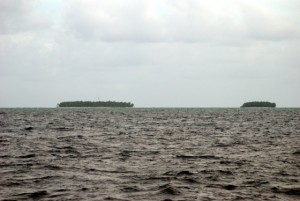 until 1:00. When I got up, we could see Cayo Albuquerque, a couple of densely wooded (mostly coconut trees) small islands in the middle of nowhere. The ocean floor goes from 7000 feet to a large shallow bank very abruptly here. I had read and heard that the island locations are incorrect on C-Maps and Navionics charts – those are the two that we use. We had some waypoints that Anton from Albatross had given us, and I had obtained some other ones from cruising blogs. The entry to Albuquerque is a little tricky, given the numerous reefs and coral heads in the area, and we were arriving in the afternoon under overcast conditions, so we couldn’t see under the water well. The route from Anton looked fairly straightforward. As we approached the entry waypoint on the north side, sea conditions started to improve, and I observed that the depth contours on the C-Maps chart were very accurate. Perhaps the charts had been updated.
until 1:00. When I got up, we could see Cayo Albuquerque, a couple of densely wooded (mostly coconut trees) small islands in the middle of nowhere. The ocean floor goes from 7000 feet to a large shallow bank very abruptly here. I had read and heard that the island locations are incorrect on C-Maps and Navionics charts – those are the two that we use. We had some waypoints that Anton from Albatross had given us, and I had obtained some other ones from cruising blogs. The entry to Albuquerque is a little tricky, given the numerous reefs and coral heads in the area, and we were arriving in the afternoon under overcast conditions, so we couldn’t see under the water well. The route from Anton looked fairly straightforward. As we approached the entry waypoint on the north side, sea conditions started to improve, and I observed that the depth contours on the C-Maps chart were very accurate. Perhaps the charts had been updated.
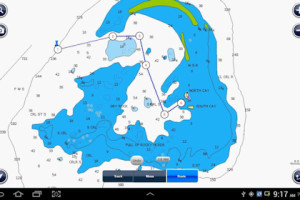 We entered the route and followed the twists and turns. We only got shallow (under ten feet) once, which was shown on the chart. Shortly before arriving in the anchorage, the radio lit up with a call from the military personnel on the island. Columbia has a military outpost here – we suppose it is to guard against invasion from Nicaragua. Russ from Jacana had told us that they spend a month here, and then rotate back to Columbia. The guy didn’t speak English, and I wasn’t quite sure what he was asking for. In the meantime, we are at the anchorage, and Rose is waiting for me to issue the “drop it” command for the anchor. I was talking to the guy, and suddenly we were at just eight feet. As I talked, I backed up to a better spot. I was able to communicate that we had come from Panama and were on our way to Providencia, and he asked us to come ashore with our papers. Albuquerque is not a port of entry, but you do need to show the military that you have the right to be in international waters, and to advise them about your intentions. I asked for quince minutos, and he said OK.
We entered the route and followed the twists and turns. We only got shallow (under ten feet) once, which was shown on the chart. Shortly before arriving in the anchorage, the radio lit up with a call from the military personnel on the island. Columbia has a military outpost here – we suppose it is to guard against invasion from Nicaragua. Russ from Jacana had told us that they spend a month here, and then rotate back to Columbia. The guy didn’t speak English, and I wasn’t quite sure what he was asking for. In the meantime, we are at the anchorage, and Rose is waiting for me to issue the “drop it” command for the anchor. I was talking to the guy, and suddenly we were at just eight feet. As I talked, I backed up to a better spot. I was able to communicate that we had come from Panama and were on our way to Providencia, and he asked us to come ashore with our papers. Albuquerque is not a port of entry, but you do need to show the military that you have the right to be in international waters, and to advise them about your intentions. I asked for quince minutos, and he said OK.
We anchored the boat, but the sonar was issuing a periodic alarm that we were at eight feet, while the depth gauge was showing a consistent thirty-three feet. I put on a mask and dove around the boat, to find that we were nowhere close to a shallow point. We ate quick sandwiches, and then dropped the kayak for the trip ashore. We were greeted by the commanding officer. The soldiers here are from “Infanteil de Marina”, which is not the Navy – the officer told us in Spanish that they guard land, but land by the water. Perhaps they were Marines. Anyway, he just wanted to know the boat name, documentation number, our next port, and our names, which he wrote down in a logbook. We explained that we would be spending the night, and leaving the following night. He was very friendly, and we promised to bring him a shirt the next day.
We returned to the boat, had some welcome drinks, cleaned up, and pretty much passed out. My seasickness had dissipated once we entered the passage through the reefs, so I was feeling fine, but very tired. We decided that we would leave just before dusk, since the anchor chain appeared to be wrapped around some coral, and Rosé wanted to leave with some light as we piloted through the reefs. We estimated a thirteen hour passage to Providencia, but we could always slow down if we left earlier than planned. Considering the higher fuel burn we had at the 1800rpm’s necessary to maintain 5.7 knots on the passage here, we could use a low fuel burn night.
Position at destination: 12°09.9’ N, 81°50.6’ W
Air temp: 90°, Humidity: 64%, Water temp: 87°
Nautical miles for this leg: 179.3
Departed at 8:30am, arrived at 2:30pm (one day later)
October 31st: Cayo Albuquerque – Isla Providencia, Columbia
We had a great day at Albuquerque. The weather was clear and sunny, with a light sea breeze. We took the kayak to shore and delivered the Tropical Blend tee-shirt to the commanding officer, and took a bunch of photos – this island definitely looked like a tropical paradise!
There was a reef about one hundred meters off of our port bow, so I swam out for an afternoon snorkel. It turned out to be a fabulous little reef, with tons of tropical fish and a wide variety of coral. It rose up about thirty feet from the sandy bottom, so there was a mini drop-off. The water clarity was good, as was the light, so I regretted not taking the underwater camera.
We had an early dinner and pulled the anchor just before dusk. We had no problem exiting, following the track we made when arriving. For a very short period, we had following seas and a favorable current, but that didn’t last long. We soon found ourselves with the waves coming into our starboard bow and a nasty opposition current. We had plenty of time for this passage, so we ran the engine at 1600rpm’s and made around five knots. It was calm enough to grab some sleep, so I laid down in the salon while Rosé took the early watch.
Late that night, we passed by San Andres Island. This is the main vacation island for Columbians. They refer to it as their Hawaii. It has a busy airport, and lots of high-rise hotels. We decided not to stop there – in Columbia, you have to check-in and pay at each port of call, so we decided to head straight for Providencia, the quieter of the two islands. I got up around 11:00PM, and I was amazed how many airplanes were flying into the San Andres airport. It seemed like a new plane was landing every ten minutes. I took over the watch, and settled in for a long night with The Beatles. It wasn’t too rough, although we did go through a few squalls. In the morning, we spied Isla Providencia and started our approach into the harbor. The harbor is big, but very shallow, with most depths less than ten feet. We got fairly close to the town dock, and anchored in about ten feet of water, with just three other boats in the harbor.
Position at destination: 13°22.8’ N, 81°22.4’ W
Air temp: 84°, Humidity: 70%, Water temp: 85°
Nautical miles for this leg: 81.8
Departed at 6:00pm, arrived at 10:30am (one day later)




